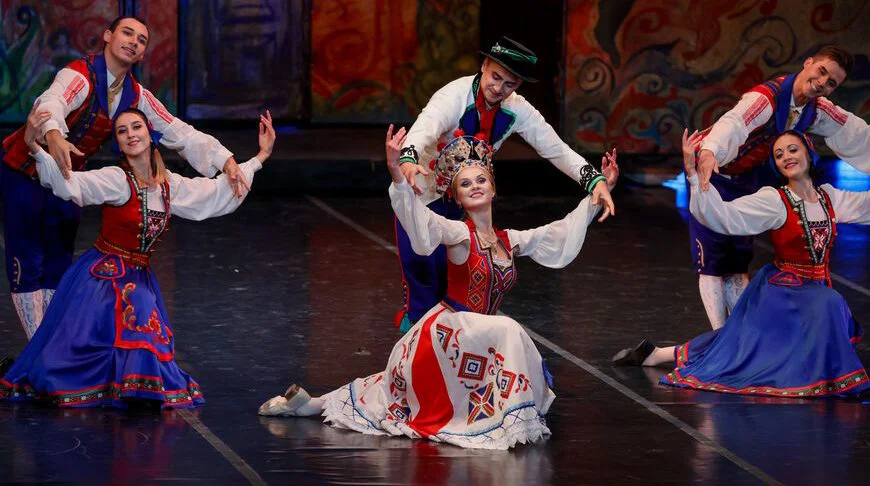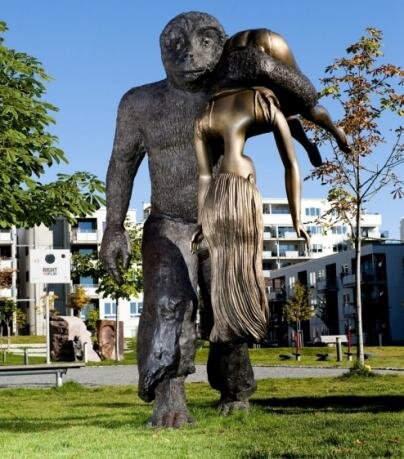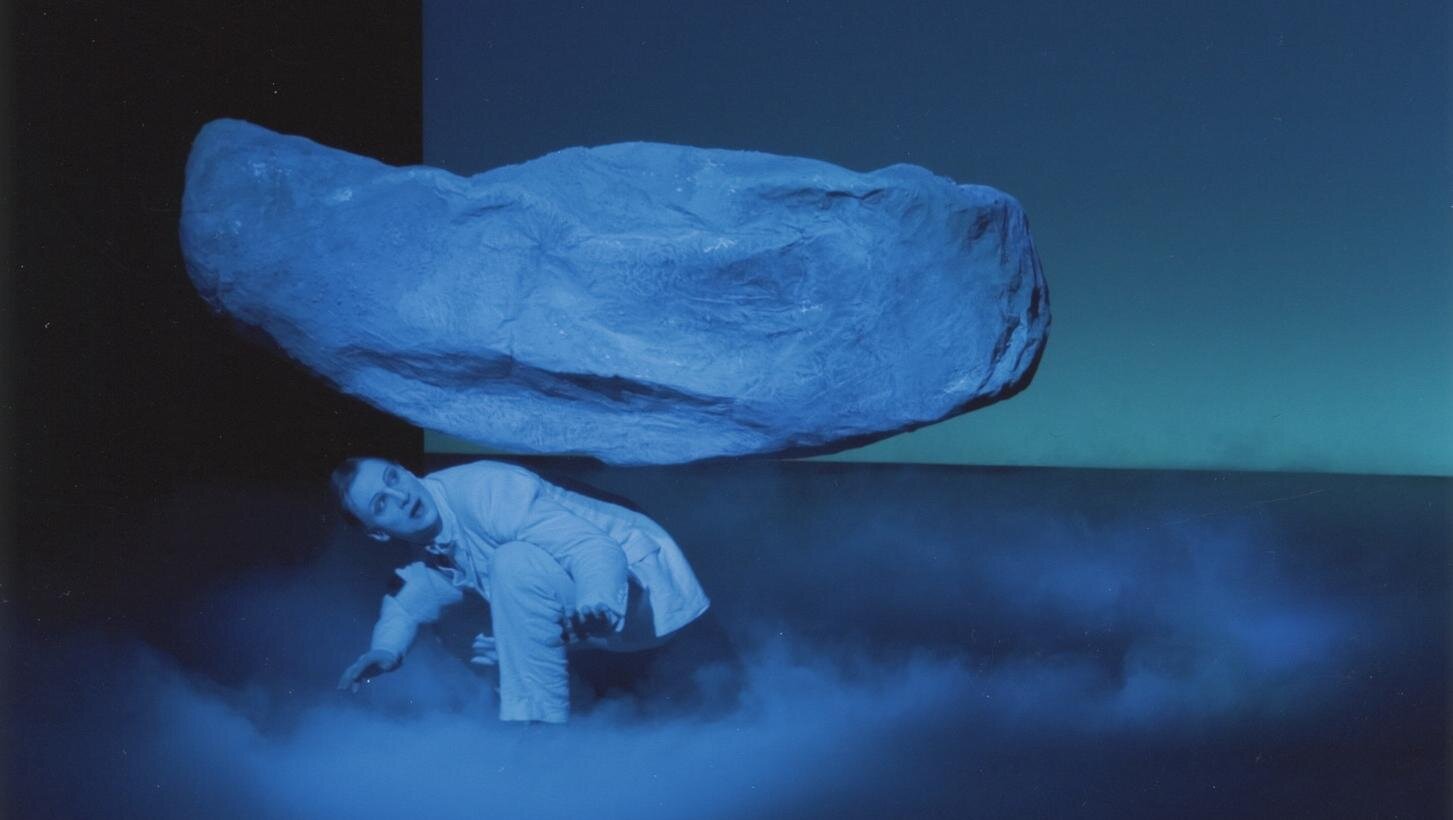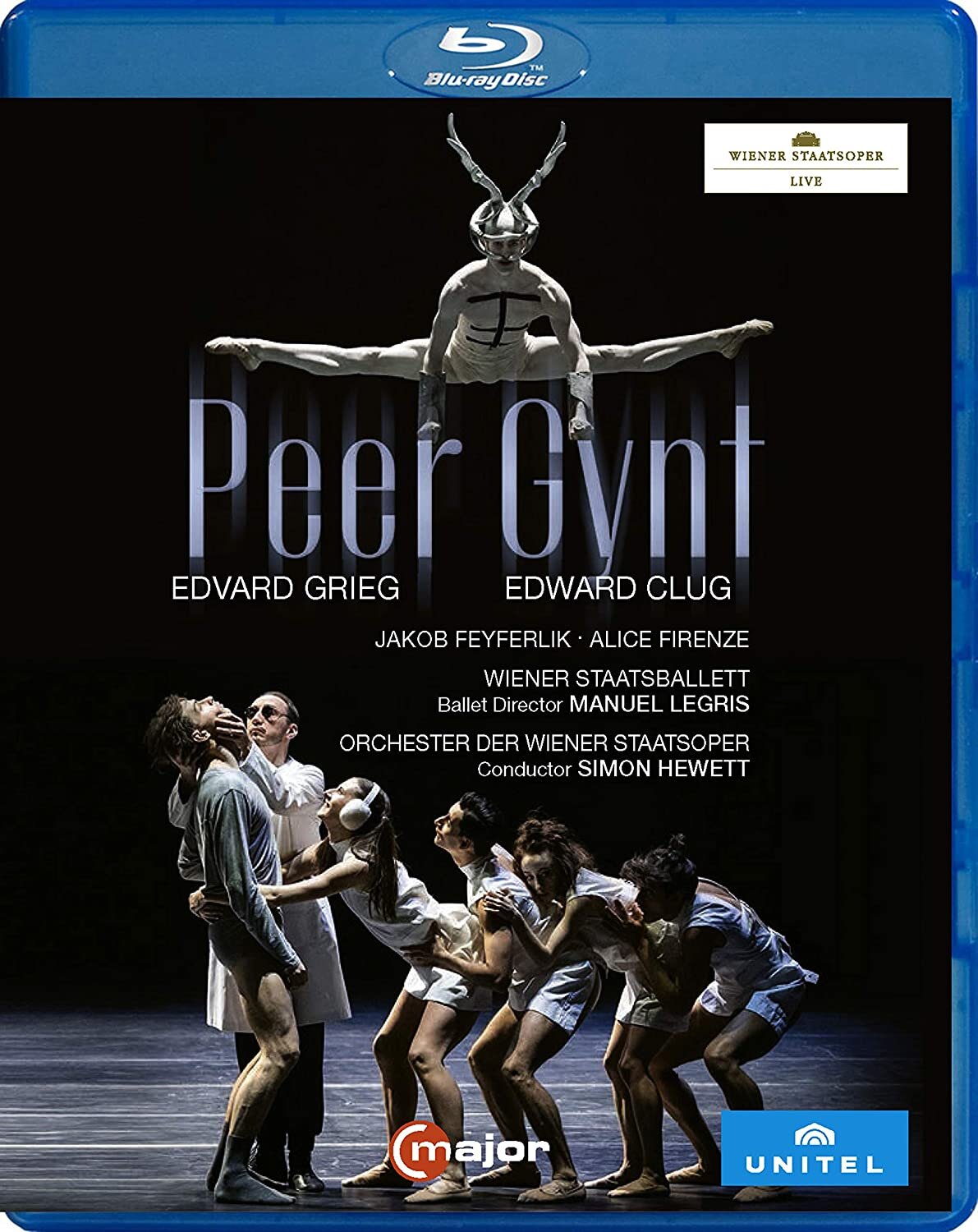
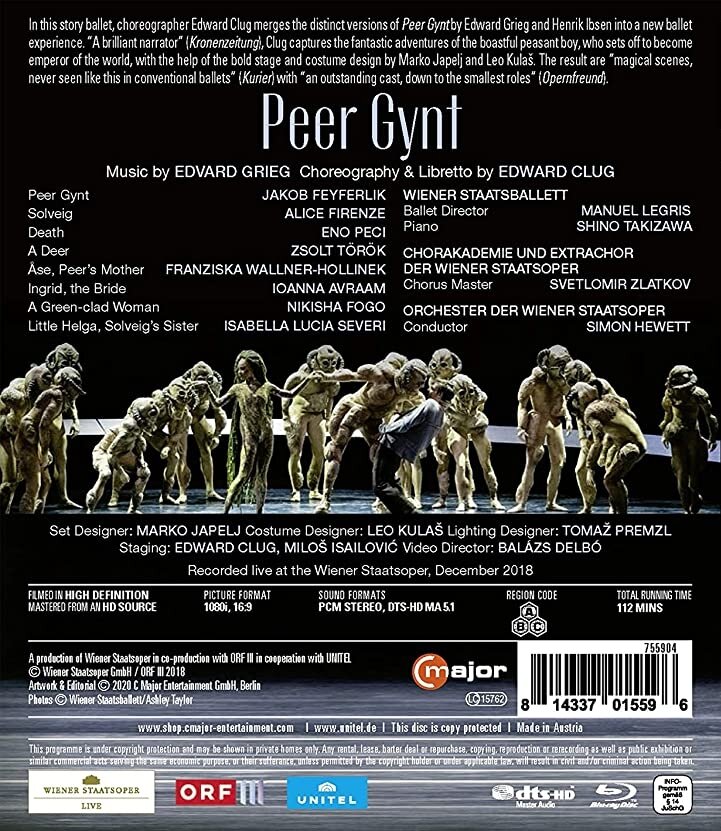

Peer Gynt ballet. Choreography and libretto by Edward Clug after the play in verse by Henrik Ibsen. Music by Edvard Grieg. Staged 2018 by Edward Clug and Miloš Isailović at the Wiener Staatsoper. Stars Jakob Feyferlik (Peer Gynt), Alice Firenze (Solveig), Eno Peci (Death), Zsolt Török (A Deer), Franziska Wallner-Hollinek (Åse, Peer’s Mother), Ioanna Avraam (Ingrid, the Bride), Nikisha Fogo (A Green-clad Woman), Isabella Lucia Severi (Little Helga, Solveig’s Sister), András Lukás (Dr. Begriffenfeldt), and dancers from the Wiener Staatsballet (Ballet Director Manuel Legris). See PS for more credits for dancers. Simon Hewett conducts the Orchester der Wiener Staatsoper and the Chorakademie und Extrachor der Wiener Staatsoper. Also features pianist Shino Takizawa, répétiteur and soloist of the Wiener Staatsballet. Set design by Marko Japelj; costume design by Leo Kulaš; lighting design by Tomaž Premzl. Directed for TV by Balázs Delbó. Released 2020, disc has 5.1 dts-HD Master Audio sound. Grade: B
Ibsen’s Peer Gynt is an anti-apprentice-story play, written in verse, in which the anti-hero messes up in innumerable ways as he comes to complete ruin as an old man—but is redeemed by the love of a girl he left behind decades earlier. Peer is the rascal all men long to be and all women long to meet wrapped up in a tornado of satire demolishing stuffy 19-century mores. As a mix of traditional lore and phantasmagorical modern ideas, critics trashed it. But Ibsen said the poem would become a monument of Norwegian literature, and he was right. Grieg wrote orchestra music, Peer Gynt, Op. 23, especially to illustrate the poem. But Clug draws on all of Grieg’s music for his ballet.
When I watched this title cold, I knew nothing about the Peer Gynt poem and little about Grieg’s music. Clug’s show was bewildering. So I immediately ordered the Dover Edition of the poem translated into English (see the cover in the picture gallery above) for about $7, which qualified for Amazon Prime delivery the next day to my door. (I still somehow feel guilty for receiving such amazing service for so little money.) The play is 137 pages of wicked satire of what has been called the “culture of avoidance.” If you want to prepare to watch this ballet, go to the Amazon button below and buy the Dover book. It has a bunch of old-fashioned English words you never saw before, but with a dictionary handy, it’s a fun read.
Before we get into a discussion of Clug’s libretto and designs, I’ll show you how Peer Gynt has inspired the wildest conceivable variety of set designs, drawings, paintings, and works of sculpture. This will soften you up for what you encounter on Clug’s stage. In the 1st Scene of Act 1 of the poem, Peer tells his mother, Åse, lies about an epic struggle in the mountains with a reindeer, the “White Buck.” The White Buck is not a character in the play—just a tiny episode—but he has inspired hundreds—maybe thousands—of art works. Below is a White Buck statute by Andrea Bucci:
Early in the play, Peer goes to a wedding, shown next below in a traditional setting from the Bolshoi Ballet:
But now let’s consider two images of Peer from the wedding party scene. On the left is a drawing by Arthur Rackham, called Peer and Solveig, about a girl Peer flirts with at the wedding party. On the right is The Abduction of Ingrid by Jim DIne. Ingrid is the bride-to-be that Peer abducts from the wedding and rapes (statutorily) in the mountains:
After the rape, Peer has to flee his village and you probably know he pays a visit to the Hall of the Mountain King (of the Trolls). Next below is a painting by Armand Demeulemeester called The Hut of the Mountain King:
Below left is an animated image of the Mountain King. On the right is a view from a Robert Wilson production—maybe Peer is dodging a rock thrown at him by the Troll King:
And finally a contemporary impression from the Norwegian artist Elling Reitan called Solveig’s Song:
Now let’s see some screenshots of Clug’s vision for Peer Gynt. Clug opens with Peer (Jakob Feyferlik) contending with the White Buck (Zsolt Török). As mentioned above, in an effort to explain a long absence, Peer lies to his mother, Åse, about a monumental struggle he had with the White Buck. His ploy almost works, but eventually (per the text) Åse remembers she heard this same tall tale before and becomes even more furious with hapless Peer. The White Buck thus becomes a symbol forever of Peer’s inveterate vaingloriousness:
The original Peer Gynt fairy tale was about a virtuous hunter who saves virgins from trolls. Ibsen turns Peer into a complete rascal who wastes his life using his sex appeal to take advantage of women, knowing full well that his victims will always forgive him in the end (or steal him blind). If you have encounter this type in your life, you know how they also can have considerable success in business, but always wind up in bankruptcy. (Ibsen’s Peer might even remind one of a certain ex-President of the United States of America.)
After Peer recovers from the White Buck scolding he gets from his mother, he learns that the wealthy farm girl Ingrid (Ioanna Avraam) is about to wed poor Mads Moen (Igor Milos), both seen below at their wedding party. Neither looks very happy:
Peer crashes the party. Below Peer first flirts with Solveig (Alice Firenze) and steals her heart. This is OK as she is eligible:
But the juicy target is Ingrid, heiress to the big farm. All the wedding guests start to sober up when they see (per the text) Peer and Ingrid climbing high above them on the steep slope headed for the mountain forest, where Ingrid spends her wedding night with Peer instead of Mads. This is the famous abduction and rape. On the first morning after this escapade, Ingrid is astonished when Peer tells her to go back in disgrace to her father. Many more adventures await Peer that are more interesting than Ingrid:
The text has 38 often wildly-disjointed scenes over 5 Acts. This was considered baffling when the poem was first published in 1867. (That was 2 years after the end of the Civil War in the United States and shortly after Wagner finished Trlstan und Isolde. Freud was 11 years old.) Today’s reader will have few problems with structure of the poem. But how to stage this in a ballet? All Clug can do is to hit the highlights with 13 scenes. To tie scenes together with some degree of lineal story-telling, Clug adds Death (Eno Peci) as a protagonist, who is not a character in the text at all. So, for example, when Peer’s actions turn the wedding party into a drunken brawl, Death intercedes to freeze the action and let Peer elope with Ingrid. Putting Death in as a character is pretty radical, but it works to keep the dancing going:
Following the rape, Peer is cut off from the village. What will he do for female company? Three “High-meadow Girls” present themselves, but they prefer having sex with trolls to men. Suddenly a mysterious Woman in Green appears. Turns out she is the daughter of the Troll King. Well, if there are no human girls available, a troll-princess might be fun!
Peer, let me introduce you to Daddy:
The Troll-King is willing for Peer to marry his daughter if Peer will himself become a Troll. According to the text, Peer gets pretty far into the troll-initiation until he learns that he must sacrifice his eyes. That is a deal killer. Peer flees:
On his way back to mom, Peer has a tryst with Solveig, who is hopelessly in love. A poor girl, she gives all she has in a ravishingly beautiful pas de deux to part of the Adagio from Grieg’s Piano Concerto in A minor (played ravishingly by Shino Takizawa):
Finally, Peer makes it home, but Åse is dying to infinitely sad strains of The Death of Åse from Op. 23. Now Peer must flee Norway and seek his fortune elsewhere in the wide, wide world:
Where ever Peer roams, he never completely forgets Solveig. He knows she is waiting for him:
Clug does a fine job of culling through all of Grieg’s music for passages to relate to his 13 scenes—only 5 scenes use music from Op. 23. I never paid much mind to Grieg before—now I understand he is one of the masters of romantic symphony and chamber music of the 19th Century. Below Peer is doing well in Morocco! 7 women do Anitra’s Dance from Op. 23:
Per the text, Peer was successful in business selling idols to China and slaves to the market in Charleston, South Carolina. To compensate for these odious lines of business, he promoted sending missionaries to China, who then, of course, bought their supplies from Gynt’s trading company. But after a North African woman he was pursuing stole all his money, Gynt winds up in Dr. Begriffenfeldt’s (András Lukás) asylum for the mentally ill in Cairo:
“Begriffenfeldt” is not a word in German. But as coined by Ibsen, it would make one think of “fields of concepts” an apt satirical name for the administrator of an insane asylum. Clug needs a vehicle to get all his dancers on the floor. What could be more fun for all than dancing around insanely?
The inmates are fascinated with Peer and make him their king; his crown reminds us of the White Buck:
After a lifetime of misadventures, Peer returns home broke and broken:
Solveig is still waiting for Peer. In the text, she is rewarded for her loyalty, but Clug is more ambiguous about the outcome:
Clug is a Romanian dancer and choreographer who has been active for decades with smaller dance companies, especially in Eastern Europe. He has long been the artistic director and choreographer at the Slovene National Theater in Moribor, Slovenia. It seems most of his work has been in abstract modern dance, but he has done an excellent job of taming the Peer Gynt beast into an entertaining evening of narrative ballet. He created his Peer Gynt in Moribor in 2017. Then he got the opportunity to take his new show and artistic team to the big house in Vienna. Wow! A complete new cast including some of the best dancers in world. It was a dream come true, and the Vienna dancers also seemed to relish the chance to master a new and crazy piece!
And best of all, now Clug got to hear his compilation of Grieg excerpts played by the incomparable Vienna State Ballet Orchestra with glittering solo piano playing by Shino Takizawa! Top this off with excellent SQ and you have the makings of an A+ recording.
But alas, why is this whole program so dark? As you see from our screenshots, often even the faces of the main dancers are covered in deep shadows. Well, Moribor is a city of 115,000 souls in a tiny country. I rather imagine the annual budget for sets at the National Theater of Slovenia in Moribor is not extravagant. This might explain why Clug’s SOP for ballet productions is to start with a black box and then add dancers, some costumes, maybe a handful of props, and then lights. Next below are several shots of other productions by Clug following this make-the-most-of-what-you-got approach.
Below left, Clug’s Carmena Burana. Below right, Le sacre du prentemps:
Below left, Stabat Mater. Below right, Left Right Left Right:
Strangely, in the 4 screenshots of other Clug work, there is plenty of light on the dancers. But now consider the lighting in Clug’s 2017 setting of Peer Gynt in Moribor, which you can see in the YouTube clip below:
The Peer Gynt video made in Moribor seems somewhat brighter than the file from Vienna, but it is still pretty dark. We must conclude that Clug and his team in Vienna were going for the maximum Carravagio effect—take it or leave it.
The video in Vienna was shot by Balázs Delbó, a newcomer to these pages, but an old hand in Austrian media. I didn’t have the energy to run the numbers all the way through on this. Instead I took 3 samples: (1) Chapters 2-3 of the wedding party, (2) Chapter 7 of the death of Åse, and Chapter 10 with the berserk patients in the Begriffenfeldt hospital. Delbó’s pace tends to run 6 to 8 seconds per clip in the lively scenes and 14 seconds in the mourning for the death of Peer’s mother. The pace is too fast. Conclusion: the video suffers from DVDitis.
Now to a grade. We start with A+ for a fine new narrative ballet with interesting and charming dancing. I go to B for the darkness of the video and further to a C for DVDitis. But I move the grade back up to a B for the wonderful orchestral playing and SQ. The house and Delbó missed a great opportunity to make an A+ recording. The camera still can’t see in the dark as well as the human eye. And when the pace of the dancing accelerates, there’s no need to pick up the pace.
Here’s a trailer for the Wiener Staatsballett live show (with a slightly different cast from what you see on the C Major Blu-ray):
PS: More dancers credited in the keep-case booklet are:
Villagers: Emilia Baranowicz, Fiona McGee, Rikako Shibamoto, Céline Janou Weder, Madison Young; Marcin Dempc, Alexandru Tcacenco, Andrey Teterin, Arne Vandervelde, Géraud Wielick
Three Dairymaids: Katharina Miffek, Iulia Tcaciuc, Chiara Uderzo
Troll King: Kamil Pavelka
Trolls: Elena Bottaro, Marie Breuilles, Natalya Butchko, Sveva Gargiulo, Oxana Kiyanenko, Fiona McGee, Suzan Opperman, Alaia Rogers-Maman; Giovanni Cusin, Marian Furnica, Andrés Garcia Torres, Trevor Hayden, Scott McKenzie, Gabor Oberegger, Tristan Ridel, Navrin Turnbull
Maroccans: Vanessza Csonka, Fiona McGee, Suzan Opperman, Rikako Shibamoto, Iulia Tcaciuc, Madison Young; Marat Davletshin, Marian Furnica, Trevor Hayden, Gabor Oberegger, Hanno Opperman, Gaetano Signorelli, Arte Vandervelde
Four Lunatics: Gala Jovanovic, Fiona McGee; James Stephens, Richard Szabó
Lunatics: Isabella Lucia Severi, Emilia Baranowicz, Elena Bottaro, Marie Breuilles, Natalya Butchko, Vanessza Csonka, Suzan Opperman, Oxana Kiyanenko, Rikako Shibamoto, Madison Young; Zsolt Török, Kamil Pavelka, Alexis Forabosco, Marian Furnica, Andrés Garcia Torres, Tristan Ridel, Gaetano Signorelli, Alexandru Tcacenco, Andrey Teterin, Arne Vandervelde, Géraud Wielick
OR

